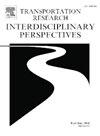Safe delivery of goods and services with smart door locks: Unlocking potential use
IF 3.9
Q2 TRANSPORTATION
Transportation Research Interdisciplinary Perspectives
Pub Date : 2025-01-01
DOI:10.1016/j.trip.2024.101309
引用次数: 0
Abstract
The purpose of this paper is to identify the potential of using smart door locks in unattended home delivery of goods, and at home services (unattended and attended) by producing new knowledge on Potential adopters and Non-adopters. Survey data on Potential adopters and Non-adopters were statistically analysed to identify their 1) characteristics (sociodemographic, interpersonal trust and technological literacy), 2) stated demand for unattended home delivery of goods and 3) attitudes regarding in-home services using smart door-locks. Results suggest that potential users are resourceful and more sociable than non-adopters. Furthermore, they have a higher problem perception. Potential adopters are more positive to let in cleaners, craftsmen, healthcare personnel, service personnel, in-fridge delivery services and pet sitters into their home unattended using smart door locks. Regarding goods, they are more positive towards delivery of sports equipment and furniture and appliances. Due to the differentiated needs of Potential adopters and Non-adopters, we propose a typology based on three dimensions (Technological trust, Social trust and Life management needs). Increased understanding of potential users’ delivery preferences can be used in the smart door lock market development. The proposed typology can e.g. be used in the upscaling of smart door locks for home delivery of goods and services by diversifying strategies to meet varying adopter needs. A successful unattended delivery system behind closed door can reduce the number of failed deliveries, porch piracy, and unnecessary trips to let in service providers, and might enhance perceived flexibility and convenience of consumers.
求助全文
约1分钟内获得全文
求助全文
来源期刊

Transportation Research Interdisciplinary Perspectives
Engineering-Automotive Engineering
CiteScore
12.90
自引率
0.00%
发文量
185
审稿时长
22 weeks
 求助内容:
求助内容: 应助结果提醒方式:
应助结果提醒方式:


